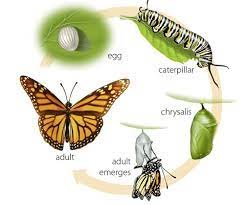Butterflies and Gardening 101
Intro to Butterflies and moths
Butterflies and moths are part of the Lepidoptera family, meaning “scaly wings”. These scales act like tiny solar panels, helping the insects absorb heat from the sun to control their body temperature efficiently. The scales are also very fragile. They’re designed to break off easily to help butterflies evade predators. Instead of getting stuck in a spider web, the scales slide right off and the butterfly is free to fly away! This also means its very important to never handle a butterfly or moth by their wings.
Here is a magnified photo of a butterfly’s wing, with all of its tiny scales clustered together.
life cycle
Butterflies undergo metamorphosis during their life cycle. They begin as eggs, and as they mature as caterpillars they begin to form a what’s called a chrysalis or a cocoon. The chrysalis is a hardened layer of skin created by the larva of butterfly species. Caterpillars of moth species create a cocoon made of silk that they spin and wrap themselves in. Most species remain in their chrysalis for 10-14 days. When a butterfly or moth “hatches” after they metamorphosize, we call that emerging.
general gardening
To host butterflies in your yard, the first step is to attract them with food. Butterflies and moths will be interested in fragrant, colorful flowers with plenty of nectar. Because of the way their compound eyes function, they will be more attracted to groups or clusters of flowers rather than plants that are spread farther apart. For the best results, a wide variety of flowers and plants will create a more complete habitat. Plantings should be done in areas that have lots of access to sunlight, which is great for the plants and for the butterflies, as well as shelter from high winds. Some species enjoy tall flowers, others prefer low bushes. Providing shelter from predators and rain with leafy or bushy plants will also help foster the health of your butterfly community. Finally, it is best to avoid pesticide use. While they may be effective at deterring weeds or predators, they also harm the plants and insects your trying to grow! Additionally, a healthy predator population will ensure that the caterpillars don’t overrun your garden and eat more than you’ve planted.
host plants
Caterpillars and adult butterflies and moths eat different plants. Caterpillars feed on leaves and other plant parts, while butterflies and moths feed on nectar. Because of this, adult butterflies and moths will only lay their eggs on the plants that their larva will eat. We call these host plants. Each species has their own preferred host plant. Most famously is the monarch butterfly and its host plant, the milkweed, pictured below.
In this case, the monarch butterfly chooses the milkweed plant because it is one of the few species that can eat it. Milkweed is a poisonous plant, which protects it from most other herbivores. The monarch caterpillar, however, is able to digest the poison and uses this ability to protect itself. The toxins remain inside the caterpillar during metamorphosis, meaning the adult butterfly is also poisonous. This, combined with its bright warning colors, keeps predators like birds and spiders away.
In general, host plants encompass a variety of species. Trees, vines, bushes, flowers, herbs, and vegetables all function as host plants for different species. The host plant will be the primary food source for the caterpillars, so make sure you have enough to keep up with their hungry, hungry appetites.
nectar plants
Before butterflies can lay eggs, though, they need to eat! These nectar plants are the ones you want to be most fragrant in order to attract some flying friends with the lure of sweet nectar. Once again, it is important to offer a variety. To get the most efficient nectar garden, consider plants like asters and milkweed that offer a large number of flowers on a small area. Another important factor to consider is flower shape and size. Because of their proboscis, the long, tongue-like appendage that functions as their mouth, they are adapted to drink from tubular flowers that other pollinators can’t access.
Members of the lepidoptera family also often need flowers that they can land on. This can take the form of flowers with large petals, like daylilies, or flowers with large clusters like milkweed, both of which are pictures below.
Tiger lilies in bloom. The long petals provide a landing spot for butterflies to dip their proboscis into.
Clusters of flowers from the milkweed plant allow butterflies to drink from multiple flowers without moving, which is like sitting at an all you can eat buffet!
Species and their host and nectar plants
Below is a chart of common Long Island butterflies and their host pants, as well as nectar plants likely to attract them. Many species of butterfly and moths have quite a few different host plants, so this list is by no means comprehensive. Links to additional resources on butterfly gardening will be provided below.







